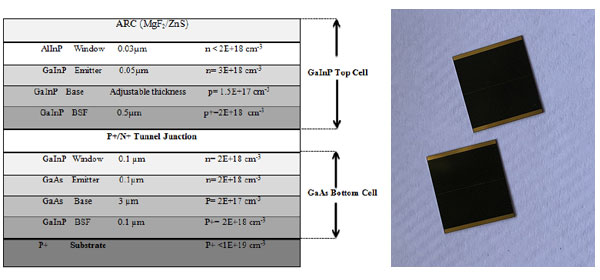The invention relates to an equipotential network triple junction gaas solar cell structure, which includes n three junction GaAs solar cell components, wherein: Ν Is the natural number greater than 2; In the present preferred embodiment, the efficiency of each triple junction gallium arsenide gaas solar cell I is greater than 28%; The radiation resistant glass cover plate is attached to each triple GaAs solar cell I; The thickness range of the anti radiation glass cover is 0.12mm-0.3mm; MgF2 antireflection film is evaporated on each radiation resistant glass cover sheet, and ITO transparent conductive film is evaporated on the MgF2 antireflection film; The thickness of ITO transparent conductive film is not more than 15nm; A pair of ITO film metal electrodes 1 are evaporated on the ITO transparent conductive film_ 1 ; The resistance between 1-1 of each pair of ITO film metal electrodes shall not be greater than 1kq; Each triple junction GaAs solar cell module consists of m three junction GaAs solar cells, of which m is the natural number greater than 2; The ITO film metal electrodes of the m-junction GaAs solar cells are connected in series through ITO interconnectors 3; After n three junction GaAs solar cell modules are connected in parallel with each other through ITO bus 2 and wire 4, they are connected with satellite structure through hinge 5.

In recent years, with the rapid development of society, the demand for energy is becoming larger and larger. However, because of the limited reserves of traditional resources (such as coal, oil, etc.), scientists need to constantly explore new energy, such as the most well-known wind, solar, tidal energy, etc. As we all know, because of the long life of the sun, solar energy is considered as inexhaustible and inexhaustible new energy.
At present, triple junction GaAs solar cell is a widely used power supply in the space field. In recent years, the space industry in China has developed rapidly. The triple junction GaAs solar cell array, which provides energy for satellites, has been widely used in the space field. The number of satellites that have been used to detect the electromagnetic field, ionospheric plasma and high energy particles to obtain the information of space electromagnetic and ionosphere is increasing year by year. The necessary condition for in-situ detection of plasma and electromagnetic field is that the interference of satellite to the space detection object should be reduced to the degree of non observability, that is to say, the satellite is "invisible" relative to the plasma. This requires that the potential of the satellite be controlled within a certain range, usually ± 2V, that is, the "equipotential" in the patent.
At present, China has a deep understanding of the charge / discharge characteristics of satellite surface. However, for the gaas solar cell array surface with a large proportion of the satellite surface, especially for satellites with equipotential requirements, there is little research on potential control technology. The application of equipotential network technology in triple junction GaAs solar cell array is still a blank stage.